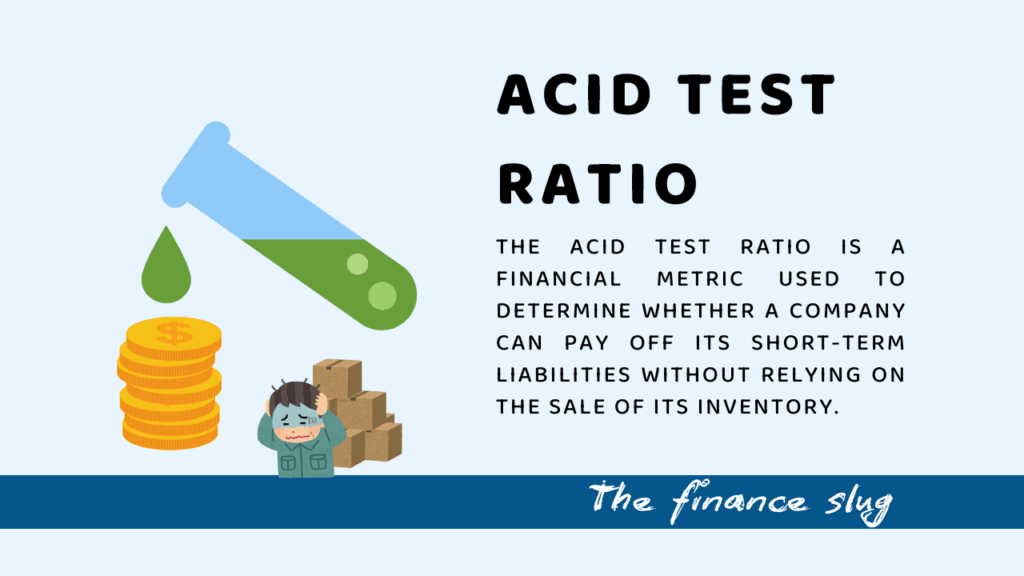
The acid test ratio, also known as the quick ratio, is a financial metric used to determine whether a company can pay off its short-term liabilities without relying on the sale of its inventory. It is one of the most critical tools for analyzing a company’s liquidity, meaning its ability to convert assets into cash quickly to meet financial obligations.
What Is the Acid Test Ratio?
The acid test ratio is called a quick ratio because it only looks at liquid assets that can quickly turn into cash. It excludes inventory, which may take time to sell and is not guaranteed to sell at its recorded value.
This ratio is widely used by financial analysts, business owners, and investors to evaluate a company’s ability to handle short-term debts or emergencies. A higher ratio indicates that a company is in a stronger position to pay its short-term obligations, while a lower ratio may signal financial trouble.
Why Is It Called the Acid Test Ratio?
The term “acid test” comes from a method used to test metals for gold. If a metal passed the acid test, it was confirmed to be gold. Similarly, the acid test ratio tests the “true strength” of a company’s liquidity by excluding assets like inventory that may not convert into cash immediately.
Why Is the Acid Test Ratio Important?
Understanding the acid test ratio is crucial because it:
- Measures Liquidity: It shows if a company can meet its immediate financial obligations without delay.
- Helps in Financial Decision-Making: Investors and lenders use this ratio to decide whether to invest in or lend money to a company.
- Highlights Financial Risks: A low ratio can signal that a company may struggle to pay its short-term debts, leading to potential financial distress.
For students studying finance or accounting, mastering this ratio is essential for analyzing the financial health of businesses.
Formula for Acid Test Ratio
The formula for the acid test ratio is:
Acid Test Ratio=(Current Assets – Inventory)/Current Liabilities
Breaking Down the Formula:
- Current Assets: These are short-term assets that a company expects to convert into cash within a year. Examples include cash, accounts receivable, and short-term marketable securities.
- Inventory: This refers to goods that a company plans to sell. Since inventory may take time to sell and may not always sell at full value, it is excluded from the calculation.
- Current Liabilities: These are the debts or obligations that a company needs to pay within a year, such as accounts payable, short-term loans, and accrued expenses.
By subtracting inventory from current assets, the formula ensures that only the most liquid assets are considered.
Example of Acid Test Ratio Calculation
Let’s consider an example to make this concept clearer:
Company A’s Financial Data:
- Cash: $50,000
- Accounts Receivable: $30,000
- Short-Term Investments: $20,000
- Inventory: $40,000
- Current Liabilities: $100,000
Using the formula:
Acid Test Ratio=(50,000+30,000+20,000−40,000)/100,000
Acid Test Ratio=60,000/100,000=0.6
What Does This Mean?
Company A has an acid test ratio of 0.6. This means for every $1 of liability, it has $0.60 in liquid assets. A ratio below 1 indicates that the company may struggle to cover its short-term debts without relying on inventory sales or other non-liquid assets.
Ideal Acid Test Ratio
Generally, an acid test ratio of 1 or higher is considered good.
- Ratio above 1: The company has more than enough liquid assets to cover its short-term liabilities.
- Ratio equal to 1: The company can just cover its liabilities with liquid assets.
- Ratio below 1: The company may face challenges in meeting its short-term obligations.
It’s important to note that the “ideal” ratio can vary by industry. For example, retail businesses may have lower ratios because inventory forms a significant part of their current assets.
Acid Test Ratio vs. Current Ratio
While the acid test ratio and current ratio are both measures of liquidity, there is a key difference:
- Current Ratio: Includes all current assets, including inventory.
- Acid Test Ratio: Excludes inventory, focusing only on liquid assets.
Because of this difference, the acid test ratio is often considered a stricter and more accurate measure of a company’s immediate liquidity.
Limitations of the Acid Test Ratio
While the acid test ratio is useful, it has its limitations:
- Industry Variations: The ratio doesn’t account for differences between industries. For example, a retail company with high inventory levels may have a lower acid test ratio but still be financially stable.
- Short-Term Focus: It only considers short-term liabilities and doesn’t give a complete picture of long-term financial health.
- Excludes Inventory: In some industries, inventory can be quickly sold, making it a liquid asset. Excluding it might underestimate liquidity in such cases.
Why Should Students Learn About the Acid Test Ratio?
Understanding the acid test ratio prepares students for real-world financial analysis. Whether you’re pursuing finance, business management, or accounting, this concept is a cornerstone for evaluating a company’s financial stability.
It’s especially valuable for those aiming to become financial analysts, accountants, or business consultants, as it provides a reliable way to assess a company’s liquidity at a glance.
Conclusion
The acid test ratio is a simple yet powerful tool to measure a company’s ability to meet its short-term obligations using liquid assets. By excluding inventory, it provides a clearer picture of immediate liquidity.
For students, mastering this ratio is essential for understanding financial statements and analyzing the health of businesses. Whether you’re preparing for exams or real-world applications, this concept will be a valuable addition to your financial knowledge toolkit.
FAQ: Understanding the Acid Test Ratio
Here are some frequently asked questions about the acid test ratio to clear up any confusion:
Article Sources: ICAI Guide







